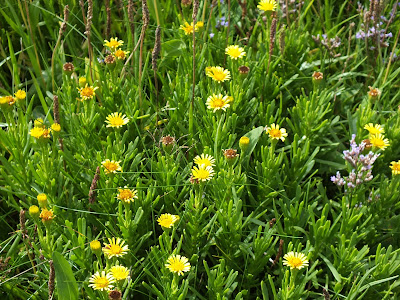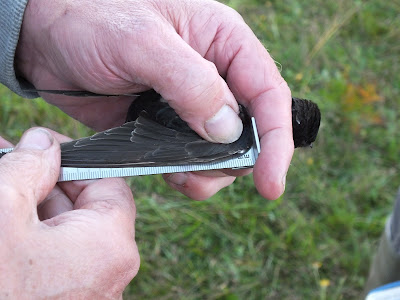Guided Walk, salt marsh and dunes...
Three hardy souls joined me this morning for a look at the plants and animals of the salt marsh and the dunes.
The morning was briefly overcast and gloomy, but soon the skies cleared and a gentle breeze developed, by the end of the walk it was quite warm.
The salt marsh at Pembrey burrows is a key element of its designations as an SSSI, along with the other joint designations the reserve has of Special Area of Conservation, (SAC), and Special Protected Area, (SPA). For interest here is a taste of why the whole of the Carmarthen Bay is so important.
The Carmarthen Bay and Estuaries SAC is a multiple interest site which has been selected for the presence of ten interest features that qualify under Annex I and Annex II of the Habitats Directive.
For the qualifying habitats and species the SAC is considered to be one of the best areas in the UK for:
• Estuaries • Mudflats and sandflats not covered by seawater at low tide • Atlantic saltmeadows (Glauco-Puccinellietalia maritimae) • Salicornia and other annuals colonising mud and sand • Large shallow inlets and bays • Sandbanks which are slightly covered by sea water all the time :
CARMARTHEN BAY SPA Carmarthen Bay has been designated as a Special Protection Area under the Birds Directive (79/409/EEC) because of the site’s European ornithological interest. The site qualifies under Article 4.2 of the Directive as it is used regularly by 1 % or more of the biogeographic population of a regularly occurring migratory species: common scoter Melanitta nigra. Non-qualifying species of interest are red throated diver Gavia stellata, velvet scoter Melanitta fusca, eider Somateria mollissima, Manx shearwater Puffinus puffinus.
The reserve sits in a truly outstanding part of the world....
This morning we saw a good range of the salt marsh plants including Golden Samphire, Sea Aster, Common Sea Lavender and Sea Purslane.
 |
| Golden Samphire |
There were good numbers of bees on the marsh flowers including Honey Bee, Common Carder, Red tailed, Buff/White tail, and possible Moss Carder.
 |
Must have been something interesting there!,
look at the Common Sea Lavender in the background. |
The butterflies didn't disappoint, with Meadow Brown, Large White, Gatekeeper, Grayling, Common Blue, and Small Blue.
 |
| Grayling |
There were a few birds around with a decent flock of c40 Linnet, along with Meadow Pipit, Skylark and a family party of Stonechats.
It was nice to see a few late summer fungi beginning to show including this earthball?, I'll confirm the id later. (see update)
 |
| Common Puffball, confirmed by Dr Philip Jones our local expert |
The earthballs (Scleroderma) have a very tough 'skin' and do not have this sort of 'spine' on the surface but smooth or have coarse scales (like rough skin = scleroderma!). I think this is one of the puffball species. Look closely at the spines and groups of points seem meet ----- so I think this would be Lycoperdon perlatum = common puffball. These spines drop off leaving a 'pearly' pattern on the surface. At this young stage, if cut open, the inside would be white ---- later a powdery light brown (spore colour). Earthballs have a tough skin which breaks down for spore release and, when cut, are blackish inside.
One you may see on dune grassland is Bovista plumbea (Grey Puffball) which has a white smooth surface when young -- this outer coat breaks away with a tough inner grey (lead-grey) coat beneath. This species does not remain fixed to the soil but soon breaks loose to be blown about by the wind and so release spores over a wide area. Cunning beasts. Philip:
many thanks to Philip for his help....


























